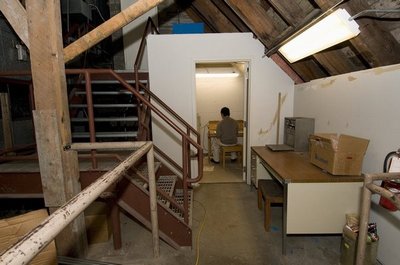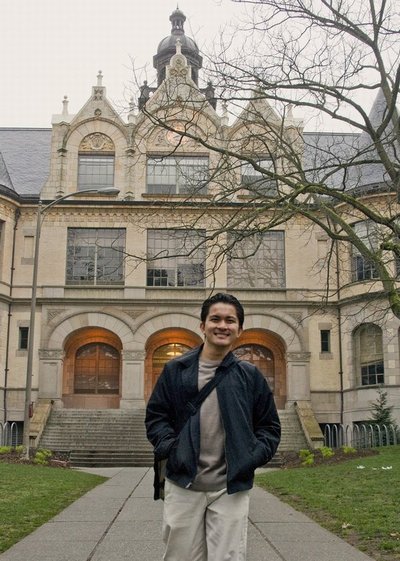January 28, 2010
The carillon carries on: Continuing a century-old School of Music tradition
Resonant, bell-like tones from Denny Hall sound the Westminster Chimes and mark the hours each day. But — have you heard? — three mornings a week those magnificent chimes play music, too.
It’s the sound of the carillon, a beloved campus feature dating back nearly a century, in one form or another. The chimes each hour are automatic and preprogrammed, but if you hear other tunes emanating from Denny — perhaps as you pass on a foggy morning, coffee in hand — that’s the work of Gabriel Manalac, a graduate student in music.
Manalac mounts the stairs to Denny’s fourth floor to a small room — “it’s pretty much a cement block of a room with a keyboard in it,” he said — just after 8 a.m. every Monday, Wednesday and Friday. He plays on the carillon for about 10 minutes, taking it slow so the echoing notes don’t compete with each other as they drift through the air.
It’s one of the coolest part-time jobs on campus.
“I love it, because being a pianist and practicing all the time, the carillon is a pleasant change of pace,” Manalac said. “My teacher jokes with me, saying, ‘Playing the carillon, you’ll have the biggest audience of your career.'”
That teacher is Robin McCabe, professor and former director of the School of Music, who hired Manalac for the job — and held the same position once herself.
“As an undergraduate music major I was thrilled to have the job,” McCabe said. “It’s a singular position, if you will, and an opportunity to have a bit of fun. I keep a lookout for someone with the right character comportments — who’s outgoing, does not feel daunted, and has an intuition to know some pieces would not sound good.”
Manalac fills the bill nicely. “We’ve been lucky, this is his second year,” McCabe said. “He’s one of those personalities that thrive in that situation. He’s creative, with wit and imagination.”
Still, he’s something of a secret up there in Denny, playing away like a capeless Phantom of the Opera. “I don’t talk about it that much,” he said. “Not a lot of my friends know I play it — probably because they are not awake that early.”
And that funny line about him playing his biggest audience is based on the truth, McCabe said. “It was the largest captive audience I’ve ever had in my life,” she said with a chuckle. “Even at Carnegie Hall people could get up and walk out!”
But an unexpected challenge awaits any carillon player that Beethoven himself might have appreciated: the keyboard room is so isolated, it’s impossible to actually hear the notes as they boom across campus. “I honestly don’t know how it sounds outside,” Manalac confessed. He tends to ask others whether songs he plays are recognizable, and adjust his playing as needed.
And as with most anything, there is a small downside: the loud carillon generates a few complaints every year from campus neighbors who find the chimes distracting. For that reason, its playing is limited to the short time between classes on those three days, and certain special occasions.
The carillon will celebrate a centennial soon. Gary Louie, media maintenance technician for the School of Music and a longtime UW employee, is something of a local expert on the instrument. The first carillon was in a refurbished water tower on 17th Avenue NE near the observatory, Louie noted (and proved with old news clips). It was a real carillon — an array of huge bells donated by then-Seattle Times publisher Col. Alden Blethen.
That carillon was destroyed by fire and replaced by an electronic version in 1949. When it started wearing out, it too was updated in 1994 with one that plays digital “samples” of real carillon bells, broadcast by speakers.
And so finally comes the question, what songs work best for the carillon, that huge instrument whose player can’t really hear even when playing?
“I like to try and mix it up,” Manalac said, adding that the music can’t be too complex. He said he tends to prefer “stately hymns that are rhythymically stable.” He added, “The way it is, you play a note and it really rings out across campus.”
He said Amazing Grace sounds good on the carillon, as does America the Beautiful. He also likes certain show tunes such as Gershwin’s haunting Summertime or the lovely When You Wish Upon a Star. Manalac keeps a book of notes about which songs succeed and which do not.
One has to ask, though — is Manalac ever tempted to throw in a relatively recent pop song? The music graduate student replied, “Not to say anything bad about today’s tunes but a lot are — not as melodic in a way.” On the other hand, Cole Porter tunes tend to sound good on the carillon, he said.
McCabe said she had great fun with choosing what to play, and found that even a couple of Beatles tunes such as Yesterday were carillon-worthy. She said as a big game drew near she liked to play the opponents’ fight song, but as a slow, mournful dirge. Another time, she said, “I played the WSU fight song in E flat minor. It was the day before the game, and people were in hysterics over it.”
But she, too, said that the carillon must be played slowly, to allow the notes room to drift. Clearly, part of the fun is trying things out. “Most succeed, but there are a lot of failures,” Manalac said good-naturedly.
So if you’re near Denny Hall one morning and hear a hymn or a Cole Porter tune drifting through the mist, you know you’re listening to a UW tradition. And Gabriel Manalac, the man behind the music this year at least, enjoys making the campus carillon sing.
To a point, that is. He does tell this story: “I was asked to play for three whole hours for convocation, at the end of the year. I said yes without hesitation. But in those three hours I felt I aged 20 years.”
Editor’s note: Gabriel Manalac is also one of the winners of the School of Music Concerto Competition, and will perform as part of the concert with the University Symphony tonight, Jan. 28, at 7:30 in Meany Hall. Learn more online here.



